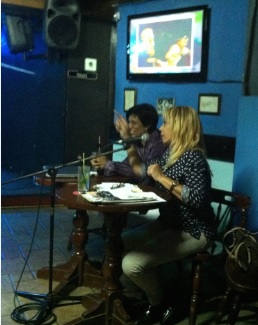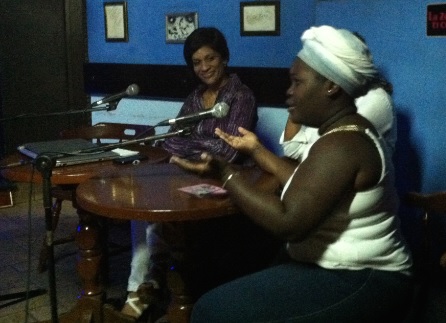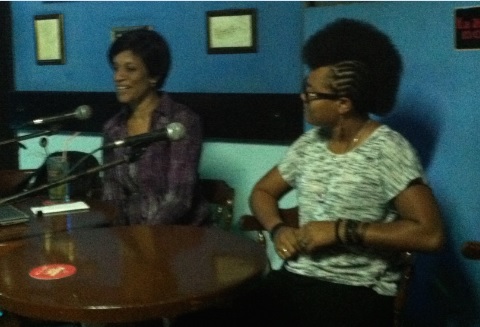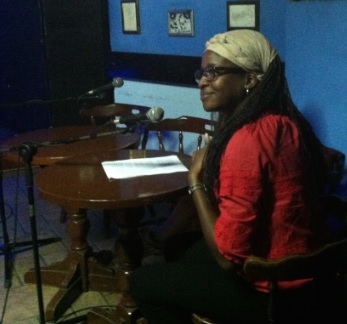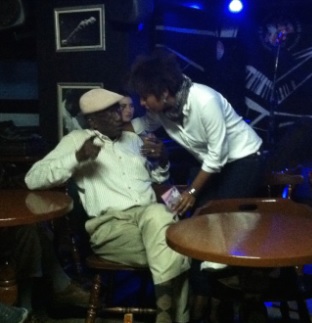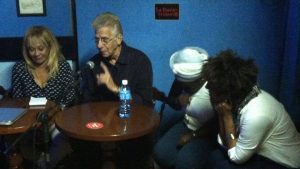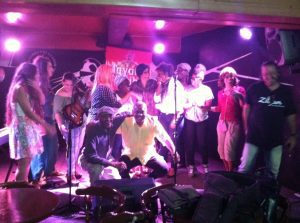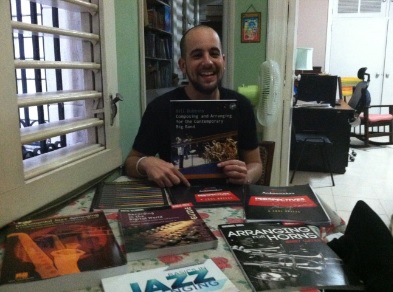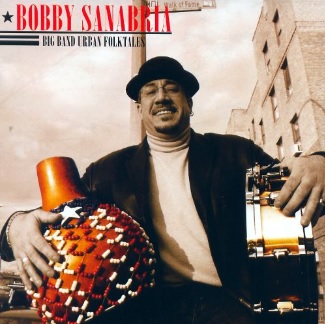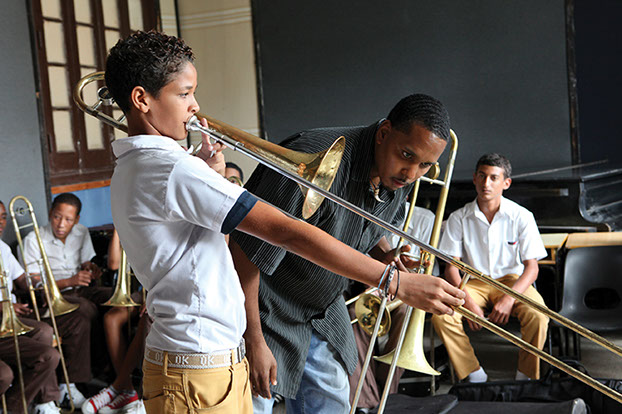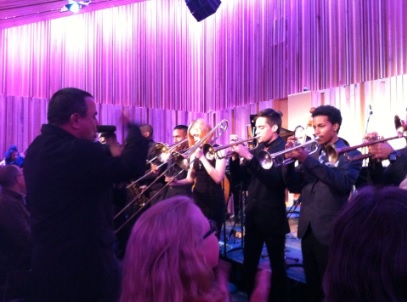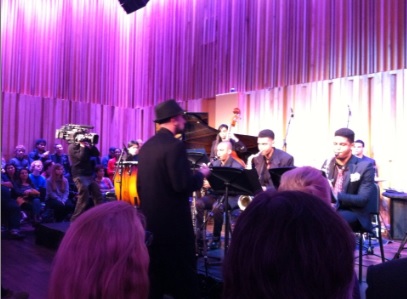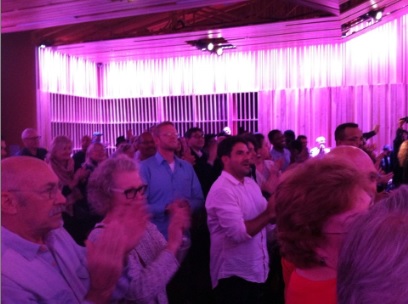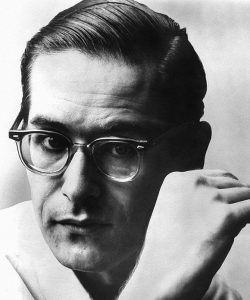Blog, Cuba, Cuban Jazz, Latin Jazz, The Cuba-US connection, Travel to Cuba, Video and audio
By marvelous coincidence, Fiesta del Tambor coincided with Cuban Women in Jazz Week.
El Zorra y La Cuarva, Havana’s pre-eminent jazz club, featured a different woman-led band every night during the week of March 6.
The truth is this scheduling only required a little rearranging of Zorra’s schedule since all of these bands already play there regularly when they’re in the country.
On Wednesday, March 8, International Woman’s Day (a holiday which began in NYC in 1909), the club hosted an all day conference on women in jazz in Cuba.
After a day of fruitful and enlightening discussion, the featured bandleaders got on stage with no rehearsal of any kind, someone called the tune “Besame Mucho” and this resulted.
Apologies to the bass player whose solo got cut off midstream. I ran out of memory and had to jettison files before I could start filming again.
 The whole gang.
The whole gang.
Click on the photo to enlarge it Bellita (Lilia Esther Exposito Pino), bandleader, composer, educator, pianist extraordinaire and organizer of
Bellita (Lilia Esther Exposito Pino), bandleader, composer, educator, pianist extraordinaire and organizer of
women’s week in jazz Singer, composer and bandleader Daimé Arocena
Singer, composer and bandleader Daimé Arocena Drummer and bandleader Yissy Garcia. Her band is BandAncha
Drummer and bandleader Yissy Garcia. Her band is BandAncha A musicologist discusses the rich history of all-woman singing groups in Cuba
A musicologist discusses the rich history of all-woman singing groups in Cuba Singer and band leader Zule Guerra talks with Cuban jazz veteran saxophonist and bandleader Rafael Quiñones
Singer and band leader Zule Guerra talks with Cuban jazz veteran saxophonist and bandleader Rafael Quiñones Legendary jazz singer Bobby Carcassés talks about scat singing with three of Cuba’s top practitioners Bellita, Daimé Arocena, and Zule Guerra
Legendary jazz singer Bobby Carcassés talks about scat singing with three of Cuba’s top practitioners Bellita, Daimé Arocena, and Zule GuerraNow let’s go to the event that brought us to Havana in the first place: Fiesta del Tambor, Festival of the Drum.
– Ken McCarthy
Jazz on the Tube
P.S. Our unique programming is made possible by help from people like you. Learn how you can contribute to our efforts here: Support Jazz on the Tube
Thanks.
Blog, Cuba, Cuban Jazz, Latin Jazz, The Cuba-US connection, Travel to Cuba, Video and audio
We went down to Havana in March to see the Fiesta del Tambor (The Drum Festival.)
We figured a drum festival in Havana had to be amazing, but nothing prepared us for the superabundance of talent and the sheer amount of music offered.
Since Jazz on the Tube is a jazz web site, we’re going to start with the jazz we encountered, but follow the thread to the end to get a more complete picture of this Treasure Island of music, both in and outside the festival.
At the Riviera Hotel, Havana
March 2017
Oliver Valdes – leader, drummer
Alejandro Delgado – trumpet
Tony Rodriquez – piano
Jorge Reyes – bass
Marcus Santos – congas
Did you recognize the tune?
It’s “Chan Chan” a 1987 composition by Compay Segundo featured in the movie “The Buena Vista Social Club.”
This is a great example of the alchemy jazz can accomplish, taking a well known melody and finding deeper magic in it. (Think John Coltrane’s version of “My Favorite Things.”)
At the Riviera Hotel
March 2017
Delvis Ponce Jove – leader, alto saxophone
Carlos Vietia – saxophone, trumpet
Michael Herrera – saxophone
Miguel Garcia – piano
Victor Cambel – piano
Edwardo Silveira – congas
Karel Kindelan – drums

Delvis Ponce Jove talks with a mystery man. Click here to discover who he is
– Ken McCarthy
Jazz on the Tube
P.S. Our unique programming is made possible by help from people like you. Learn how you can contribute to our efforts here: Support Jazz on the Tube
Thanks.
Blog, Cuba, Cuban Jazz, Latin Jazz, The Cuba-US connection, Video and audio
 Camilo Moreira our heroic educator in Havana
Camilo Moreira our heroic educator in HavanaJazz has been in Cuba for almost as long as jazz has existed. In fact, Cuban music was one of the contributors to the formation of jazz in its earliest years. (See Jelly Roll Morton’s comment on the essential role of the “Spanish tinge” in achieving the jazz feel.)
In spite of this long history, being a jazz musician in Cuba has not been easy for the last 55+ years since the free flow of audiences, musicians, records, and scores was cut off.
Cubans have extremely limited access to the Internet and the world market price of a single CD is the equivalent of a full week’s salary for them. Books, scores, and travel are correspondingly expensive and difficult to arrange.
While Cuba has an outstanding system for education in classical music (one of the best in the world), jazz education is carried out largely outside the academy and with little to no financial support.
How then does Cuba manage to produce so many world class jazz musicians?
Individual initiative and the passion and dedication of the country’s jazz community.
Growing the next generation of Cuban jazz musicians
Fledgling jazz musicians need the chance to learn their instruments, play with others, and master the theory that underpins the music.
One of the key figures in making these opportunities available to young people in Cuba today is Camilo Moreira, a friend of Jazz on the Tube.
A fine guitarist who has shifted his focus to education and composition, Camilo is a summa cum laude graduate of the Cuba’s top performing arts school University of the Arts (ISA) where he was recognized by the faculty as the best student-teacher of his graduating class.
Since 2010, he’s been teaching harmony, composition, computer music and ensemble practice at the country’s top conservatory for secondary students, the National School of Music (ENA). He also directs the school’s jazz band which was recently invited to perform at Jazz at Lincoln Center in April of 2016.
This year (2017), Camilo has taken on the important task of reviving and directing ISA’s Jazz Band. This is easily the most important jazz education initiative in the country.
How you can to help
As you can see from the picture above, Camilo likes books on composing, arranging and theory. They’re treasures to him.
For any of us, getting books on any subject is a simple matter of going to Amazon, spending a few bucks, and clicking send.
But there is no Amazon for Cubans and even if there were, a single music text can cost Camilo the equivalent of a month’s salary or more.
Up until now, that’s how he’s gotten his books, painstakingly saving his money and acquiring them catch-as-catch-can.
No more.
Jazz on the Tube has asked Camilo to give us his shopping list of the books he needs to continue his work as a teacher, arranger and composer.
We’re also on the lookout for scores and charts from, especially but not limited to, Machito and Mario Bauza, Tito Puente, Pérez Prado, and others who brought Cuban music into big band settings.
If you’re a promising young musician in Cuba, as a secondary student, you’re in ENA and as a university student, you’re in ISA. In both places Camilo is the face of jazz and we want to help him in his mission every way we can.
The power of positive leverage
It’s rare in life that such modest inputs (books and other support) have the potential to have such an oversized output.
If you’d like to be part of this project, please include a note to that effect with your next contribution to Jazz on the Tube and we’ll make sure the money you send is used for the purpose of supporting jazz education in Cuba.
By the way, in addition to being a first rate educator, Camilo is also an accomplished composer and arranger.
Using the old “sneaker net” method – flash drives passed from hand-to-hand instead of the Internet which as stated before is not easily accessed in Cuba – we’ve put some of his work online for you to enjoy.
Support Jazz on the Tube’s education projects in Cuba
Camilo wrote the score for the Cuban-made feature film “La Isla de Corcho” (“Cork Island”)
A Camilo Moreira composition and arrangement sung by Luna Manzanares: “Dejo Una Cancion”
Camilo Moreira wrote this one too: “El Trapezio de La Luna” Performed by friends and classmates from ISA. (A first reading.)
– Ken McCarthy
Jazz on the Tube
P.S. Our unique programming is made possible by help from people like you. Learn how you can contribute to our efforts here: Support Jazz on the Tube
Thanks.
Afro-Cuban culture, Artist-Educators, Blog, Jazz on the Tube Interview, Latin Jazz, Podcasts, Puerto Rico, The Cuba-US connection, Video and audio

Interview
Download the mp3 here
I say our beloved Bronx because the Bronx is a cultural treasure that all Americans can be proud of.
In this wide-ranging and fascinating conversation, Bobby Sanabria talks about the state of jazz education, the historic and ongoing contribution to jazz by Latin music and musicians, and the history of the Bronx, one of the most important centers of musical innovation in the modern world.
“The soul of the people of the Bronx is one of resilience, resistance, and pride,” Mr. Sanabria said. “It really is a majestic history.” (New York Times)
Additional references:
The official Bobby Sanabria Web Site
BMHC just broke ground last month, on January 13th, on what will be a 300-seat theater as part of a massive housing complex of over 300 apartments on E. 162nd St. and Elton Ave in the Melrose section of the South Bronx. It will open in December of 2018. This will be the permanent home of the Bronx Music Heritage Center.
From Mambo to Hip Hop
Before the Fires: An Oral History of African American Life in the Bronx from the 1930s to the 1960s by Mark Naison and Bob Gumbs Info about the book “Before the Fires”
The Clave – The Key: Africa, the Caribbean and New Orleans
What New York City sounded like when Bobby was 15. The Puerto Rican community gathers at at the Bandshell in Central Park.
– Ken McCarthy
Jazz on the Tube

Blog, Cuba, Cuban Jazz, Latin Jazz, The Cuba-US connection, Video and audio
New Orleans and Havana have a long history together.
For a while (1762 to 1802) when Louisiana (“Luisiana” in Spanish) was a Spanish holding, New Orleans was administered by Havana and the Spanish left behind many beautiful buildings.
Much of the French Quarter was actually built by the Cubans after a catastrophic fire destroyed most of the old city in 1788.
U.S. troops about to enter the Spanish-American War, which included the liberation of Cuba from Spanish control, shipped out of New Orleans and returned there (which is why New Orleans was full of used brass instruments around the turn of the century.)
Also, several members of important community brass bands were part of the force that invaded and then occupied Havana after the war. You can be sure they brought back some Cuban feel from the experience.
Dave Bartholomew, the New Orleanian who put his formative stamp on rock ‘n roll in the late 1940s, says he got the riff from his iconic “Country Boy” (used later on thousands of rock tunes including Elvis Presley’s “Hound Dog”) from a Cuba Son record.
And on and on it goes.
The history continued in January of 2017 with a visit by high school jazz students from Havana to New Orleans, the first such visit in at least 60 years (possibly the first such visit ever.)
The kids worked with musicians at Preservation Hall and gave a performance which was received enthusiastically by the city’s discriminating jazz fans.
In the captions below, we note the names of the Cuban educators who train and manage the band, two of the great unsung heroes in the Horns to Havana organization: Enrique Toledo and Camilo Moreira.
 Orchestra Director Enrique Toledo
Orchestra Director Enrique Toledo
 Camilo Moreira conducts
Camilo Moreira conducts
 Standing ovation in New Orleans for the kids from Cuba
Standing ovation in New Orleans for the kids from CubaEnrique Toledo conducts the Conservatorio Amadeo Roldán Jazz Orchestra in Havana, January 2016.
– Ken McCarthy
Jazz on the Tube
P.S. Our unique programming is made possible by help from people like you. Learn how you can contribute to our efforts here: Support Jazz on the Tube
Thanks.
Afro-Cuban culture, Blog, Cuba, Cuban Jazz, The Cuba-US connection, Video and audio
Steve Coleman in Matanzas (2017) with members of Rumba Timba. The group is made up of some of the younger members of Los Muñequitos de Matanzas. Luis Cancino Morales on the bells.
2016 marked Steve Coleman’s 20th year of exploring and playing in Cuba.
It all started with Coleman’s interest in the philosophical underpinnings of music and how complex cultural ideas are transmitted through music.
Anyone interested in this subject has to look to Africa and anyone in North America interested in African culture would do well to take a prolonged trip to Cuba.
Why Cuba?
For one thing it’s closer, but more importantly for historical reasons the concentration and variety of African cultural systems in Cuba is unprecedented anywhere on earth – even in Africa itself.
Coleman’s first visit to Cuba was in January 1996 where he wisely went straight to Mantazas one of the wellsprings of Afro-Cuban Culture.
This was followed up by a twelve day long collaboration in Havana with AfroCuba de Matanzas in February of the same year.
This initial collaboration culminated in a performance at the Havana Jazz Festival and a recording session at Egrem which produced the album “The Sign and The Seal by Steve Coleman and The Mystic Rhythm Society.
Here’s a documentary shot during the years right before Coleman went to Cuba (1993 to 1995).
In addition to being a composer, band leader, and instrumentalist, Coleman is also an educator.
– Ken McCarthy
Jazz on the Tube
P.S. Our unique programming is made possible by help from people like you. Learn how you can contribute to our efforts here: Support Jazz on the Tube
Thanks.
